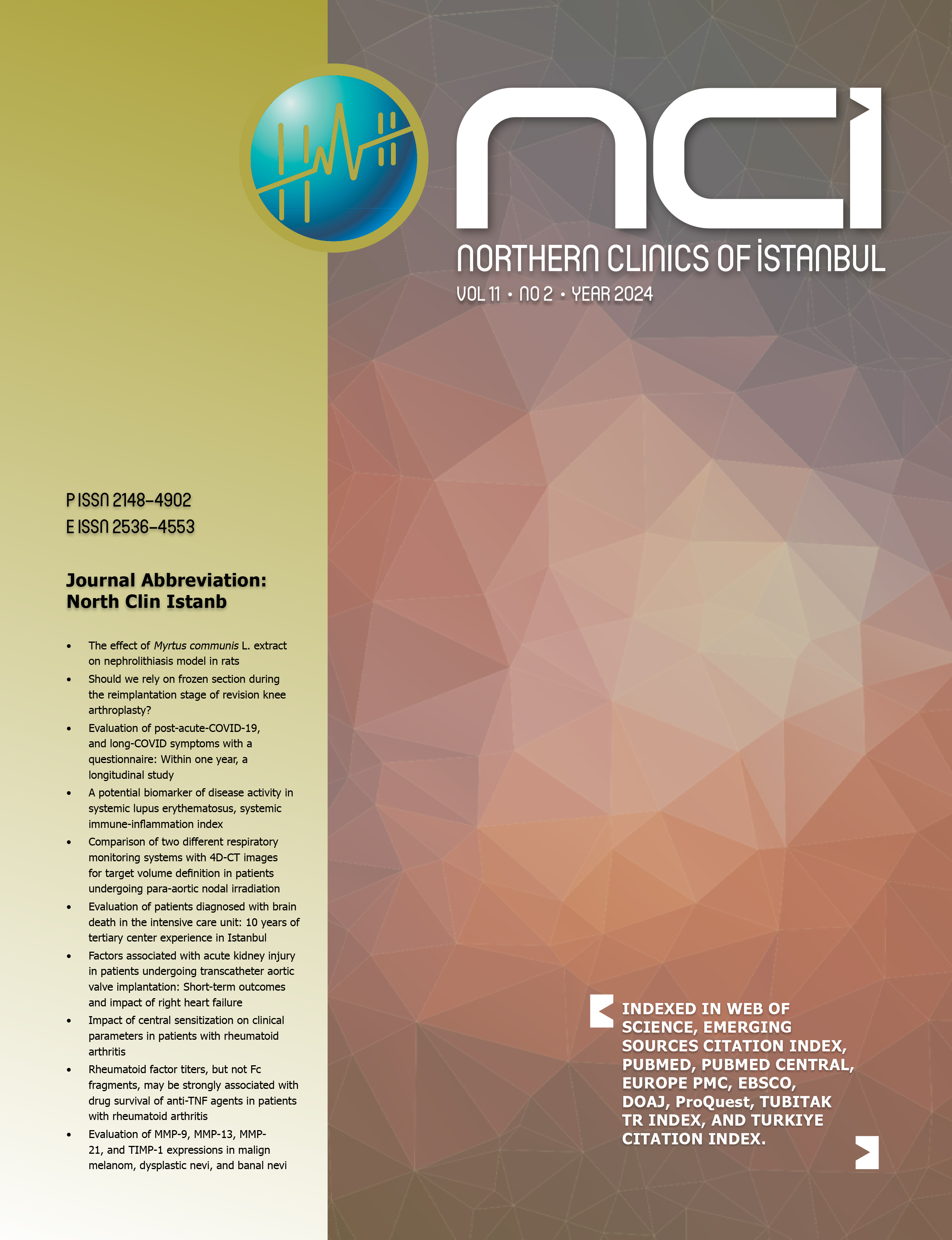Outcomes of surgery for gallbladder cancer: A single-center experience
Adil Baskiran1, Emrah Sahin1, Nese Karadag2, Tevfik Tolga Sahin1, Bora Barut1, Dincer Ozgor1, Abuzer Dirican11Department of Surgery, Inonu University Institute of Liver Transplantation, Malatya, Turkey2Department of Pathology, Inonu University Faculty of Medicine, Malatya, Turkey
INTRODUCTION: Gallbladder cancer (GBC) is a rare clinical entity that has a poor prognosis. Radical resection with meticulous lymph node dissection is the only treatment option. The aim of the present study is to evaluate the efficacy of radical resection for GBC in the early postoperative period with the viewpoint of clinicopathological correlation.
METHODS: Patients (n=24) who underwent radical resection with lymph node dissection for GBC between 2015 and 2017 were included. Demographic data, histopathologic tumor type, preoperative tumor markers, pathologic tumor size/stage (depth of invasion), lymph node metastasis and metastasis rates, and postoperative early mortality were evaluated. The patients were grouped in two groups according to lymph node metastases: Group 1 (without lymph node metastasis) and Group 2 (with lymph node metastasis).
RESULTS: The median age of the patients in Group 1 and Group 2 was 65 (range, 4289) years and 68 (range, 4887) years, respectively (p>0.05). The female/male ratio in Group 1 and Group 2 was 4/4 and 13/3, respectively (p>0.05). There was a tendency for increased metastasis in Group 2 compared with Group 1 (31% vs. 0%) (p>0.05). Also, 88% of the tumors in Group 2 were in the advanced stage, whereas the rate was 37% in Group 1 (p<0.05). There was early postoperative mortality in seven patients who underwent resection. Four of the seven patients (43%) were from Group 2 and three (37%) from Group 1 (p>0.05).
DISCUSSION AND CONCLUSION: Lymph node metastasis in GBC indicates advanced tumor stage. This causes a more complex surgical resection and therefore results in higher early postoperative mortality.
Keywords: Gallbladder cancer, radical resection; lymph node dissection; lymph node metastasis; extrahepatic biliary tree resection.
Safra Kesesi Kanseri İçin Cerrahi Sonuçlar: Tek Merkez Deneyimi
Adil Baskiran1, Emrah Sahin1, Nese Karadag2, Tevfik Tolga Sahin1, Bora Barut1, Dincer Ozgor1, Abuzer Dirican11İnönü Üniversitesi Karaciğer Nakli Enstitüsü Genel Cerrahi Anabilim Dalı, Malatya2İnönü Üniversitesi Patoloji Anabilim Dalı, Malatya
GİRİŞ ve AMAÇ: Safra kesesi kanseri nadir görülen ve çok kötü prognoza sahip bir klinik tablodur. Lenf nodu diseksiyonu ile yapılan radikal rezeksiyon, tedavinin tek şansıdır. Bu çalışmanın amacı postoperatif erken dönemde safra kesesi kanseri nedeniyle yapılan radikal rezeksiyonunun klinikopatolojik korelasyonun değerlendirilmesidir.
YÖNTEM ve GEREÇLER: 2015 ve 2017 yılları arasında safra kesesi kanseri için için lenf nodu diseksiyonu ile radikal rezeksiyon uygulanan hastalar (n = 24). Demografik veriler, tümörün histopatolojik tipi, preoperatif tümör belirteçleri, patolojik tümör boyutu evresi (invazyon derinliği), lenf nodu metastazı ve postoperatif erken mortalite değerlendirildi. Hastalar, lenf nodu metastazlarına göre iki gruba ayrıldı: Grup 1 (lenf nodu metastazı olmaksızın) ve Grup 2 (lenf nodu metastazı olan).
BULGULAR: Grup 1 ve grup 2'deki hastaların ortanca yaşı sırasıyla 65 (42-89) ve 68 (48-87) idi (p> 0.05). Kadın / erkek oranı Grup 1 ve Grup 2'de sırasıyla 4/4 ve 13/3 (p> 0.05) idi. Grup 2'de artmış metastaz eğilimi Grup 1'e göre (% 31'e karşı% 0) (p> 0.05) daha yüksek idi. Grup 2'deki tümörlerin% 88'i ileri evredeyken, grup 1 de bu oran % 37 idi (p <0.05).
TARTIŞMA ve SONUÇ: Safra kesesi kanseri tanısında lenf nodu metastazı ilerlemiş tümör evresi anlamına gelmektedir. Bu, daha karmaşık bir cerrahi rezeksiyona ve erken postoperatif mortaliteye neden olmaktadır.
Anahtar Kelimeler: safra kesesi kanseri, radikal rezeksiyon, lenf nodu disksiyonu, lenf nodu metastazı, ekstrahepatik biliyer yol rezeksiyonu
Manuscript Language: English





















